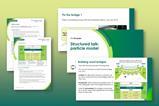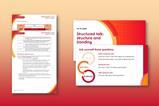Use metacognition, thinking about thinking, to help your students develop their problem-solving skills

Metacognition, thinking about thinking, helps learners to recognise how they solve problems. Doing it provides the opportunity to develop their problem-solving techniques, rather than learning the solution to a specific problem.
And it’s simple to try in class. Arrange students into groups and give each student a specific role within that group; I use talk trios. To make the most of any of the talk activities here and in the EEF Improving secondary science guidance it’s important to model and scaffold both listening and speaking; download the resource below and use it as a prompt or checklist for students and yourself to develop your classroom practice. Next, make the process visible. Use the metacognitive cycle so everyone can locate where they are in the process and where they are going.
There are five steps to the cycle:
7 simple rules to boost science teaching
Click to expand and explore the rules
Build on the ideas that pupils bring to lessons
Help pupils direct their own learning
Use models to support understanding
Support pupils to retain and retrieve knowledge
- Pay attention to cognitive load—structure tasks to limit the amount of new information pupils need to process
- Revisit knowledge after a gap to help pupils retain it in their long-term memory
- Provide opportunities for pupils to retrieve the knowledge that they have previously learnt
- Encourage pupils to elaborate on what they have learnt
Use practical work purposefully and as part of a learning sequence
Develop scientific vocabulary and support pupils to read and write about science
Use structured feedback to move on pupils’ thinking
- Assess the demands of the task, visualise both what needs to be done and what it will look like when complete.
- Assess your own skills base recognising: strengths, weaknesses and what must be mastered to move forward, an action plan.
- Spend time planning the strategies required to put the action plan into practice.
- Put the plan into action by applying the planned strategies. The real skill at this stage is to continually monitor progress and make small adjustments to the strategy accordingly.
- Once the actions are completed, allow a period of reflection. This can be as simple as asking what went well or what could be improved. From here, you can continue the cycle.
Download a prompt sheet for using talk trios as MS Powerpoint or pdf.
Using the metacognitive cycle to answer a six-mark question
Talk trios can work together using the metacognitive cycle to answer this question: ‘Describe how you could produce pure dry crystals of magnesium chloride’.
- Students recognise this is a practical procedure question. They take turns to express their thoughts and then the similarities and differences in their thinking.
- Next the students assess their own skills base. You can scaffold this by asking questions or encouraging peer questioning. For example: what do they know already, draw attention to a similar experiment that they have done. Ask them what don’t they know, what’s different about this question to the practical that they did. Question what they want to master and what additional knowledge they need to answer this question. And finally, ask what they will do to improve, and how the method used in class can be modified to answer this question.
- Encourage your students to check for logical sequencing of events – has unreacted magnesium been filtered off before crystallising the salt? Initially students will try and skip the planning phase. Ask the talk trios to compare plans, identify points they may have missed and work together to create a ‘best’ plan.
- Individually, or as talk trios, ask the students to write out an answer to the question. Remind them they have approximately one minute per mark in an exam. The real skill at this stage is to continually think about what they have planned and make small adjustments where necessary. If, for example, they planned to heat the hydrochloric acid they may now realise this is unnecessary as reaction is vigorous at room temperature.
- Reflection; ask the students to read their answer then mark it using an answer rubric and encourage the talk trios to discuss what when well and what could be improved. Ask the students to compare their ‘best’ plan to the marking rubric – what information was unnecessary or missed?
The metacognitive cycle and scientific method are immediately comparable. Draw attention to the similarities in these processes, making your students aware of how much of the process is familiar.
Stress the importance of time, emphasising how much time is needed to plan, to implement the plan, to reflect upon the outcome and how much time is available.
With practice, these processes will become internalised as a cognitive habit.
This article is part of the series 7 simple rules for science teaching, developed in response to the EEF’s Improving secondary science guidance. It supports rule 2c, Promote metacognitive talk and dialogue in the classroom.
Downloads
Talk trio prompts
PowerPoint, Size 0.16 mbTalk trio prompts
PDF, Size 73.8 kb















No comments yet